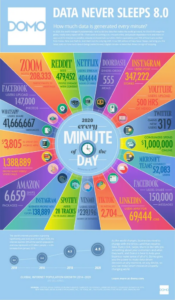Introduction
In the modern business landscape in Canada, there’s no question that digital is a huge part of any marketing strategy. The reason is simple: the average Canadian spends 5 hours/day online.
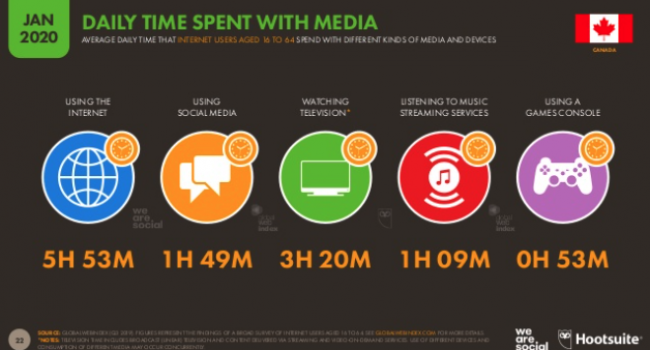
Your current and potential customers/donors are there, and you need to be able to reach them through the channels they prefer, with messages that will engage them and have them complete the actions you want.
The challenge for many organizations, however, is how to prioritize channels and tactics that will drive the greatest return in a constantly evolving, crowded landscape with a sharp learning curve.
What happens in 60 seconds online
It’s all about the “customer”
Although digital marketing may seem complex the only real differences between it and traditional/offline marketing are the tools, the speed, and the ability to see successes and failures in almost real-time. What hasn’t changed is that you need to understand your customers and potential customers first, before developing your strategy.
No matter what industry you’re in you have “customers”. You may refer to them by different names: “donors”, “partners”, “stakeholders” or something else, but ultimately they are coming to you to complete a transaction.
They want to give you something to get something — a product, a service or maybe a tax receipt or good feeling for making a donation.
But their needs and wants are changing, and organizations must also change to meet those needs, or risk losing them to competitors.
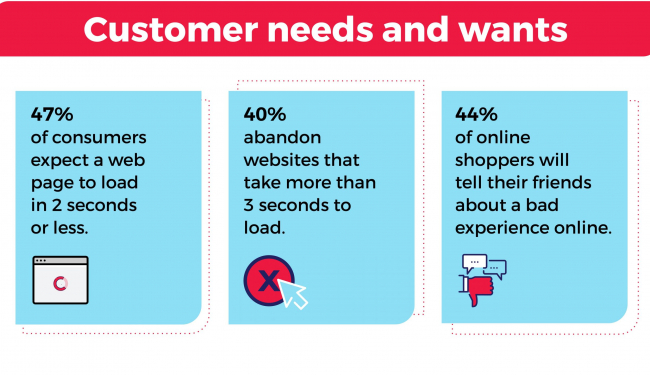
“We’re no longer competing with the best experience in our respective categories. We’re competing with the best experience a consumer has ever had.”
– Jason Spero, VP of Global Performance Solutions at Google
Your organization is facing increasing competition for audience attention. Modern users measure the quality of their experience with your organization against all the other experiences out there — not just the other charities they give to once a year. This means that they are going to compare you to Amazon, Airbnb or Uber and other brands they use every day.
You may not have the resources of those organizations — but thankfully it doesn’t take purely money to create exceptional online experiences… it’s about putting the customer first.
Where to start?
Despite the changes in channels and tactics, marketing is still about one thing — the customer. It’s about understanding their needs and reaching them with the right message, at the right time, through the right channel/medium to help them, and you, achieve an objective or solve a problem… and when you delight a customer they will tell others.
“Modern marketing is about telling a story to people who want to hear it, making that story so vivid and so true that the people who hear it tell other people.”
-Seth Godin
If you’re feeling overwhelmed already, don’t worry. There is a simple, focused plan that can help your team develop and execute a digital marketing strategy that yields results.
Throughout the other learning resources, you’ll be introduced to the strategies, tools and tactics you need to implement to maximize digital channels for your organization and to do it at your own pace.
6 steps to create your digital marketing strategy
Despite the changes in channels and tactics, marketing is still about one thing — the customer. It’s about understanding their needs and reaching them with the right message, at the right time, through the right channel/medium to help them, and you, achieve an objective or solve a problem… and when you delight a customer they will tell others.
1. Know your audience
If you don’t understand who your audience is or what they want and need from you, you’ll never be able to implement any successful marketing initiatives. In the learning module covering the customer journey, you’ll be introduced to the concept of customer personas. Personas are a snapshot of different customers with unique needs and interests. By developing a series of model personas based on a number of your unique customer groups, you’ll be able to hone in on who they are and what they want (and need) from you. Ultimately, it will help you develop more effective strategies because their needs will be more clearly articulated.
You’ll learn how to develop your own customer personas using existing database information, research, surveys, and interviews with your business’ target audience.
It’s important that all the information you use to develop your model personas is based on real data wherever possible. Making assumptions about your audience can cause your marketing strategy to take the wrong direction.
Some of the data you’ll use to develop personas:
Quantitative (or Demographic) Information
Collect this information via analytics, databases or other sources
- Location
- Age
- Gender
- Income
- Job Title
- Donation details (directed areas of interest)
Qualitative (or Psychographic) Information
This information will mainly be collected via surveys/interviews
- Goals: What do they want their donation to achieve? What are their motivations for giving?
- Challenges: What are the problems they face when interacting with all of your organizational services (not just marketing tools).
- Interests/Priorities: What social or community issues interest them the most and why?
This is by no means an exhaustive list, but rather a starting point as you begin to explore digital marketing.
2. Set measurable goals
Your marketing strategy should be directly connected to the overall goals set by your organization. Whether it’s to increase revenue by 10% or bring in 1,000 new customers, the second step is knowing how to measure it.
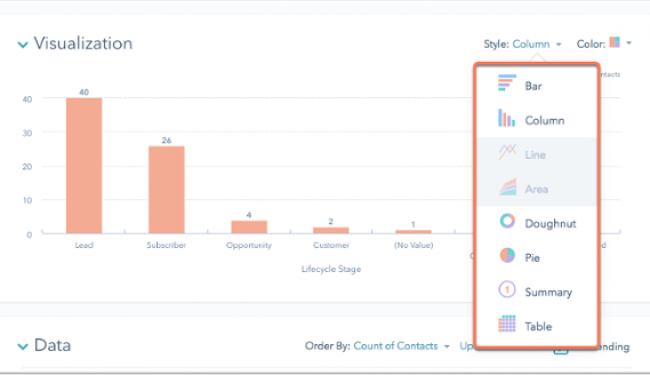
Remember, when goal-setting always use the SMART goals model:
S – specific, significant, stretching
M – measurable, meaningful, motivational
A – agreed upon, attainable, achievable, acceptable, action-oriented
R – realistic, relevant, reasonable, rewarding, results-oriented
T – time-based, time-bound, timely, tangible, trackable

Before kicking off your projects, ensure that you have established the tools and measures to accurately track progress. In many cases, analytic tool filtering will not allow you to look backwards and cover historical data. For example, if you want to filter out website traffic from internal sources, make sure that filter is in place at the start as it will only start filtering from that time forward.
3) Evaluate your existing tools and assets
When developing digital strategies, you’ll want to evaluate the tools and assets at your disposal and update existing or expand to new areas where appropriate. In the ‘Media Management’ learning module you’ll find information about the different channels available to you and when/how to leverage them effectively.
Some areas to explore before getting started:
Owned Media: The digital assets your company owns — website, social media profiles, blog content, or graphics/photos, owned channels —are the things your business has complete control over. Take stock of what you have and align your strategy accordingly.
Earned Media: The exposure that you’ve earned through press mentions, positive reviews, and by people outside of your organization sharing your content on social media. Evaluate your earned media, how much do you have, is it positive or negative, who is talking about their experience with your brand? Knowing the baseline will be valuable moving forward to measure the success of your new strategies.
Paid Media: This refers to any digital channel where you’ve spent money to gain exposure, including: digital ads, boosted social media posts, native advertising (sponsored content on other websites), and any other medium for which you directly pay in exchange for visibility. Collect all the data on what you received through paid media and consider the return on investment.
Now that you have a view of your current landscape you can start to think about what to keep and what to cut.
4) Start Producing Content
At the heart of digital marketing strategy is a content strategy.
“Content Marketing is a strategy where brands create interest, relevance, and relationships with customers by producing, curating, and sharing content that addresses specific customer needs and delivers visible value.”
-Forrester Research
You are probably already producing content in your organization in the form of blog posts, infographics, videos or social media posts. What the ‘Content Marketing’ learning module will help you do is to look at every piece of content as an opportunity to tell your brand story, to connect with your current and potential customers and raise your profile online.
A good content strategy will be closely tied to your goals — whether it’s driving sales/donations, increasing social media followers or attracting new customers. You will need to tailor your content to meet the needs of the target audience and action you want them to take.
Here are some of the steps you’ll need to follow to work out what content you need to meet your digital marketing goals:
Audit your existing content: Analyze your current content based on performance in relation to your goals. Take note of what is effective and what is not, so you can set off in the right direction with your new strategies.
Identify gaps in your existing content; once you’ve developed your user personas, you should have a good idea of what they need from you to take action. Make sure you are producing content that meets their needs, answers their questions and drives action — you won’t always get that right on the first try, but through persistence and measurement you will get there.
Create a tactical content plan: A content plan that outlines your goals but also includes the tactical details to actually deliver the items is essential. In the ‘Content Marketing’ learning module you’ll find more information along with access to templates that can help you get started. Here are some of the basics you’ll want to include:
- Title
- Format (e.g. video, blog, image, podcast, etc.)
- Target audience
- Goal/Action
- Promotional channels
- Date
- Success measure
You can use a simple Excel spreadsheet or a more advanced online tool to schedule your content, but the important thing is to get started as soon as possible.
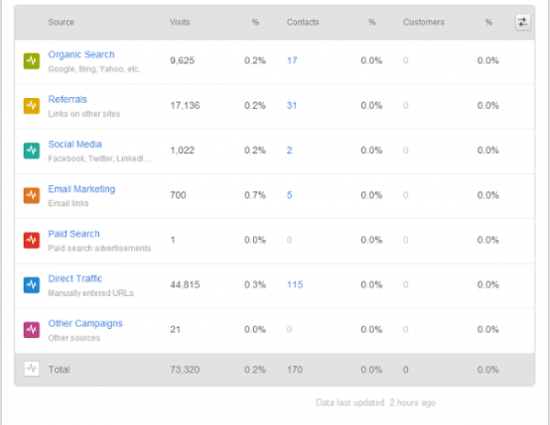
5) Measure
It can’t be stressed enough… you must take advantage of the data insights your organization is collecting in digital channels. Data can help you better allocate resources based on greatest return on investment, which social media platform is best for your target audience, or what landing page on your website is most effective for driving donations. It’s all there, waiting for you.
Summary
Digital marketing can be a complex undertaking – but with the right approach and methodology it can be a game-changer for any organization. Find out more about how you can implement winning strategies by reviewing some of our other guides.
